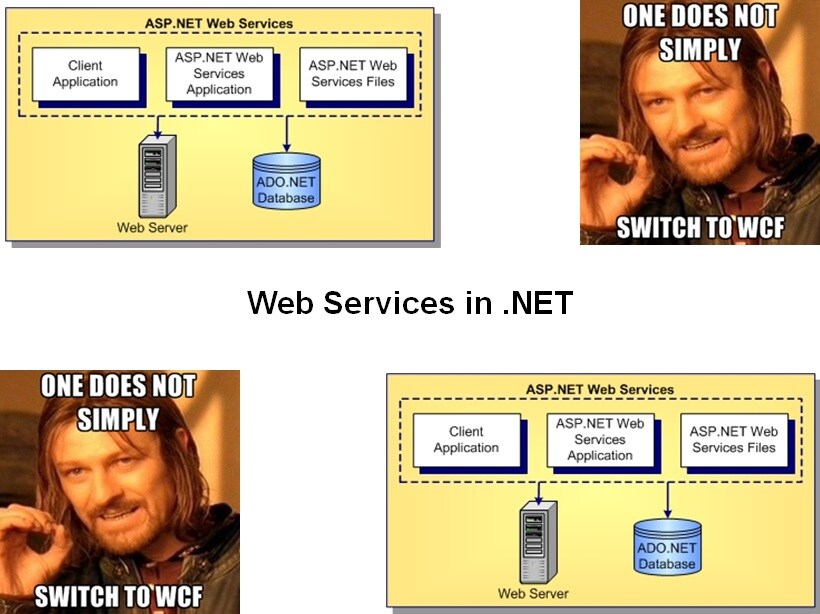-
Learning by doing
-
Trainers with practical experience
-
Classroom training
-
Detailed course material
-
Clear content description
-
Tailormade content possible
-
Training that proceeds
-
Small groups
In the course Web Services in dotNET participants learn to develop Web Services using Windows Communication Foundation (WCF) and C#. The emphasis is on SOAP services, but attention is also paid to REST Services with the Web API.
The course Web Services in .NET begins with a discussion of WCF Web Services features. Among other things, the contracts that play a role in this are discussed, such as WCF Contracts, Service Contracts, Data Contracts and Message Contracts.
Attention is also paid to the fundamentals of the Simple Object Access Protocol (SOAP) and the Web Services Description Language (WSDL) that are essential for creating interoperable Web Services. The SOAP messages from a simple Web Service are intercepted and the WSDL is analyzed.
XML Schema, which defines the content of XML messages in terms of content model and data types, is also discussed. The role of XML Schema in the mapping between XML and C# is covered as well.
The various options for hosting WCF Web Services such as self hosting, hosting in Windows services and hosting in IIS are treated.
The course Web Services in .NET also covers the techniques for creating and debugging ASP.NET Web services and contracts using Visual Studio .NET and creating Web Services clients using the direct use of the .NET API.
And the possibilities of managing WCF service instances such as per call services, per session services or singleton services are also on the agenda.
The various protocols over which WCF Web Services can operate, such as HTTP, HTTPS, TCP and UDP, and how to configure them, are treated.
How WCF Web Services can use various message patterns such as one way, request-reply, callback and sessionfull, is part op the program as well.
Finally it is discussed how REST Services, in which JSON Data is sent, are implemented with the Web API.
This course is intended for developers who want to understand and use .NET WCF Web Services in their applications.
To participate in this course knowledge and experience with C# is required and knowledge of ASP.NET is beneficial for a proper understanding.
The course has a hands-on nature. The theory is treated on the basis of presentation slides. The theory is interspersed with demos and exercises. The course materials are in English.
Participants receive a certificate Web Services in .NET after successful completion of the course.

Module 1 : WCF Intro |
Module 2 : Web Services Intro |
Module 3 : SOAP |
|
WCF versus Web Services Endpoints and Addresses WS-Addressing WCF Bindings Configuring Bindings WCF Contracts Service Contracts Data Contracts Message Contracts Fault Contracts Creating Endpoints Hosting WCF Services |
What are Web Services? Distributed Applications Evolution Role of interface RPC Example Interoperability Web Service Types Web Services Stack SOAP Web Services REST Web Services RPC Style Web Services Document Style Web Services Service Oriented Architecture |
What is SOAP? SOAP Protocol Concepts SOAP Messages SOAP Body SOAP Headers SOAP Namespaces SOAP Faults SOAP Messages as payload Message Exchange Patterns SOAP Message Path SOAP Intermediaries actor and mustUnderstand attribute |
Module 4 : XML-Schema |
Module 5 : WSDL |
Module 6 : Hosting |
| Why XML-Schema? Well formed and valid documents What XML-Schema’s? Markup Languages XML Schema Advantages XML Schema design models Classic Use of Schema’s XML Namespaces Simple and Complex types XML Schema Data Types User Defined Data Types Derivation by Restriction Derivation by Extension |
What is WSDL? Where is WSDL used? Benefits of WSDL WSDL and Code Generation WSDL in Web Service stack WSDL Namespaces WSDL Structure WSDL Elements Types and Messages PortType and Operations WSDL Bindings Service Element SOAP Messages Modes |
Hosting Types Service Description Self Hosting Service Host Creation App.config Configuration Programmatic Configuration Windows Host Managed Window Service Hosting in Windows Services IIS Hosting and .SVC File Web.config for IIS Host Windows Activation Service WAS Commands |
Module 7 : Contracts |
Module 8 : Instance Management |
Module 9 : Binding |
|
Service Contract Creating Service Contract Data Contract Service Implementation Client Side Message Pattern Message Contract Message Contract Rules Customizing SOAP MessageHeaderArray ProtectionLevel Property Name and Order Property Fault Contract |
Instance Mode Configuration Per Call Service Process of Handling Per Call Per Session Service Singleton Service Instance Deactivation ReleaseInstanceMode BeforeCall BeforeAndAfterCall Explicit Deactivation Defining Durable Services Throttling Configuration Programmatic Configuration |
Bindings and Channel Stacks Message Bubbling Basic Binding Types WS Binding Types NET Binding Types Binding Configuration Administrative Configuration Programmatic Configuration Metadata Exchange Publishing Metadata Metadata Exchange Point MEX Administrative Config MEX Programmatic Config |
Module 10 : Message Patterns |
Module 11 : Web API REST Services |
|
| Message Patterns Request-Reply One Way One Way Operation Sessionful Services Exceptions Callback Service Callback Contract Client Callback Setup Service Side Callback Invocation |
What is REST? REST Web Service Principles ID and Links REST Services with Web API Multiple Representations Embedded Path Parameters Common REST Patterns Resources URI Access JavaScript Object Notation (JSON) XML versus JSON |
